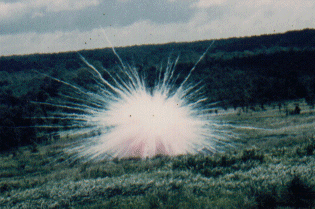|
3rd Battalion Royal Australian Regiment
Your FaithfullyJapan - Korea - Malaya - Borneo - Vietnam - East Timor - Solomons - Iraq - Afghanistan |
3rd Battalion |
|
|---|---|
| (Australian & Vietnamese language of the Vietnam era) | |
AIRBURST
|
A munition explosion either timed or angled to allow it to explode "in the air" and not upon hitting the ground. |
| AK-47 |
The AK-47 was the basic infantry weapon of the North Vietnamese Army (NVA) and the Vietcong (VC). Originally manufactured by the Soviet Union, most the the rifles that were used in the war were made in the People's Republic of China, which was the major supplier of armaments to NVA and VC forces. Also known as the Kalishnikov, after its Russian inventor, this weapon was sturdy, reliable, compact, and relatively lightweight. It fired a 7.62mm short round. Could be fired either in a single shot configuration or in a fully automatic mode. Most armaments analysts judge the AK-47, which normally holds thirty rounds, to be superior to the U.S. M-16, which became the standard weapon of American, Korean, and South Vietnamese troops. It was more durable and less adversely affected by the climate and conditions of Vietnam. There are a number of accounts of cases in which American troops preferred to use the AK-47. The AK-47 had a distinctive popping sound. |
| AO | Area of Operations |
| AO DAI (ow day) |
Traditional costume of Vietnamese women consisting of a slit skirt and trousers. |
APC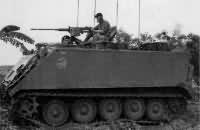 |
Armoured Personnel Carrier |
| ARTY | Short for Artillery |
| ARVN | Army of the Republic of Vietnam (Army of South Vietnam). |
| ASAP | As Soon As Possible |
| AWOL | Absent With Out Leave |
| B-52 | American bomber. It entered service in the mid-1950s.
Two B-52 units, the 320th Bomb Wing and the 2nd Bomb Wing, had their aircraft modified to carry conventional high explosive bombs. Each B-52 used in Vietnam could carry eighty-four 500-pound bombs internally and twenty-four 750-pound bombs on under wing racks, for a 3,000-mile nonstop range. The first B-52 raids against a target in South Vietnam (and the first war action for the B-52) took place on June 18, 1965. The target was a Vietcong jungle sanctuary. The results were not encouraging. Two B-52s collided in flight to the target and were lost in the Pacific Ocean. The results of the bombing could not be evaluated because the area was controlled by the Vietcong. The most effective use of the B-52 in Vietnam was for tactical support of ground troops. B-52s were called in to disrupt enemy troop concentrations and supply areas with devastating effect. From June 1965 until August 1973, when operations ceased, B-52s flew 124,532 sorties which successfully dropped their bomb loads on target. Thirty-one B-52s were lost: eighteen shot down by the enemy, and thirteen lost to operational problems. |
BA MOI BA (barmy bar) |
The term for Vietnamese beer. Pronounced as Barmy Bar.
The beer had the number 33 on the label and the Vietnamese for 33 is Ba Moi Ba.
Around the label was written *BA M'BA BGI*BEER*BIERE*BIER*BIRRA |
| BA MUOI LAM (baa mooee lamb) |
Vietnamese for the number 35. Means the same as "butterfly;" a playboy. |
| BETEL NUT | The leaves or root of the betel palm, which are mildly narcotic. Chewed by many Vietnamese, especially aged women, to relieve the pain of diseased gums. The cumulative effect of years of betel nut chewing is to totally blacken the teeth. |
| BIC | Vietnamese term for "understand". |
| BIRD DOG | Small fixed wing observation aircraft (like a cessna) |
| BODY BAG | The green/black/white plastic bags used for retrieval of bodies on the battlefield. |
| BOK-BOK | Fight or Fighting |
| BOOKOO (book oo) |
A corruption of the French word beaucoup. Means "many," or "lots of..." |
| C-4 | Plastic explosive. Could be manipulated almost to any shape or size for effect. |
| CACA DAU (cacka dow) |
Vietnamese Phrase for "I'll kill you." |
| CAL | Calibre, used in association with a number such as 40 or 50 depending on munitions round size. |
| CAM ON (CALM OON) |
Thank You. |
ANH SAT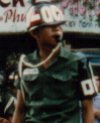 (KARN ZAT) |
The Local Police, also known as White Mice |
| CHAO CO (CHOW CO) |
Hello or Goodbye. You could also add ONG or EM for MISS or SIR , for someone that you know very well. |
| CHARLIE | Vietcong--short for the phonetic representation for VC -Victor Charlie |
| CHEAP CHARLIE | Used whenever you wouldn't buy something from their stalls or when you wouldn't buy the bar girls Saigon Tea, as "Uk da loi cheap charlie." |
| CHECK IT OUT | American slang during the late 60's and early 70's, meaning "Hey come and have a look at this". |
| CHIEU HOI (chew hoy) |
Literally means Open Arms. The Open Arms Program was instituted to encourage VC to defect. Any VC who surrounded under the Chieu Hoi program were offered amnesty. Used as a term to mean surrender. |
| CHINOOK (shin ook) 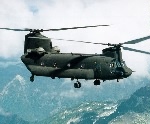 |
CH-47 Personnel and cargo helicopter |
| CHOI OI (choy oy) |
Vietnamese term, exclamation like "Good heavens" or "What the hell!" |
| CHOP CHOP | Had two meanings, either food or eat; or to hurry up. |
CHOPPER 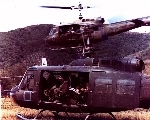 |
Helicopter |
CLACKER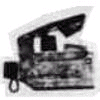 |
Hand held firing device for triggering the claymore mines and some other electrically initiated demolitions. The lever is pressed generating a small electrical charge that ignited the explosive device. |
CLAYMORE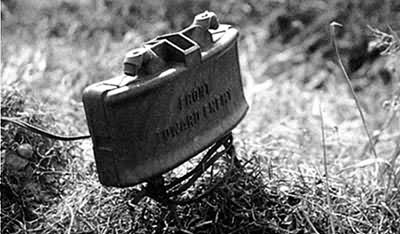 |
Fan-shaped, antipersonnel land mine.
Widely used in Vietnam, the claymore antipersonnel mine was designed to produce a directional-ised, fan-shaped pattern of fragments. The claymore used a curved block of C-4 explosive, shaped to blow all its force outward in a semicircular pattern. A large number of ball bearings were embedded in a plastic sheet laid across the face of the explosive |
| CO | Commanding Officer at any level |
COBRA |
The AH-1G "attack helicopter." The Cobra carried 2.75s, mini-guns, and a 40mm gun mounted in a turret under the nose of the aircraft. |
| CONG BO | Water buffalo |
| CONG KHI | Monkey |
| CONG MOUI | Mosquito |
| CONTACT | Called out when first in contact with the enemy, and later used to describe the event in generality. |
| COWBOY | Young Vietnamese gang member, usually riding motor bikes and often operated similar to gangs. |
| C-RATIONS | Combat rations--canned meals used in military operations |
| CYCLO | A three-wheel passenger vehicle powered by a human on a bicycle |
| DI DI MAU | Move quickly |
| DINKY DAU | Vietnamese term for "crazy" or "You're crazy." |
| DU | F*CK |
| DU MI AMI | MOTHER F*CKER |
| DUNG LAI | Vietnamese for "STOP!" or "HALT!" |
| DURRIE | Australian slang for a cigarette, particularly a rolled smoke |
| DUST OFF | Medical Evacuation Helicopter |
| ELEPHANT GRASS | Very tall, sharp-edged grass |
| EXTRACTION | Withdrawal, used to describe the taking of troops from a location. |
| FAC | Forward Air Controller The forward air controller (FAC) had the responsibility for calling in air strikes on enemy positions. Usually flying a low-level, low-speed aircraft, such as a single-engine Cessna spotter plane, the FAC relayed information to attack aircraft, helicopter gunships, or high-altitude bombers. The FAC's on the ground worked with Infantry Platoons and would call in similar information, from the ground. |
| FIELD OF FIRE | Area that a weapon or group of weapons can cover effectively. When setting an ambush position you always checked out where the field of fire was for the machine guns ... to ensure that you had the killing ground effectively covered. |
| FINI | French word for finish. Used by the Vietnamese for finish. Like when you only paid for a short time with a girl and you are taking too long she would whine "When you fini Ukdaloi?" |
| FIRE BASE | An Artillery base developed usually temporary to provide direct artillery support for the infantry soldier in the field. |
| FIREFIGHT | Describes a fierce gun fight with/without tracers |
| FIRE FOR EFFECT | Continual firing by artillery |
| FIRE MISSION | Artillery firing at particular locations |
| FLARE | Illumination projectile fired either by a mortar or by artillery that provided a substance that provided bright light suspended from a small parachute. Used to provide some light during contacts at night. |
| FO | Person who calls in artillery fire missions whilst embedded into infantry platoons. |
| FREE FIRE ZONE | An area in where civilians were not expected to be or were excluded from. Persons within these areas were likely to be enemy only. |
| FRIENDLY FIRE | Artillery or small arms fire munitions fire being received from your own forces. May occur because of incorrect coordinates or poor identification before firing your weapon. |
| FTA | F*ck The Army. A term used to denigrate the army. |
| GA MUG | Vietnamese for "Thank You" |
| GOFFER | Australian slang for a can of soft drink. |
| GOOKS | Derogatory slang expression used originally in the Korean War to describe persons of Asian origin. Used occasionally by Australians to refer to any Vietnamese, but mainly the enemy. |
| GRUNT | Describes the Australian infantry soldier. The term describes the noise an infantry soldier makes as he rises to his feet whilst lifting his backpack. |
| GUERRILLA | Irregular soldier |
| GUNG HO | Describes person very enthusiastic and committed - usually used as a derisive term by Australians. |
| GUNSHIP | A heavily munitions armed helicopter or fixed-wing aircraft |
| MPC | The money that we got paid in (Military Payment Certificate) .jpg) |
| RPG | Rocket Propelled Grenade A high explosive grenade fired from a rifle mount. |
| Uc Da Loi (ook da loy) |
Vietnamese term for Australian soldier. It literally means soldier from the South. |
 |
| The 3 RAR Internet site gratefully acknowledges the assistance of 101 design of Wollongong. www.101design.com.au |
